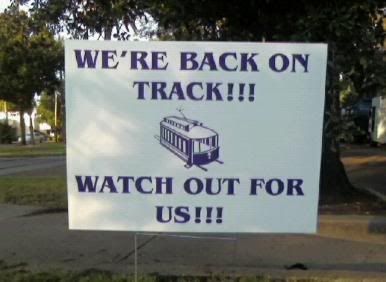Hurricanes Katrina and Rita were tough on a lot of people, but they were also tough on our animals. You could say that for our pets Callie and Smudge, it was a complete cat-astrophe!
(Okay, okay, a very bad pun. Last one, I promise.)
Callie and Smudge are our two remaining cats. Prior to the storm we had four cats and took every one of them with us when we fled town in the middle of the night almost three years ago. Packed into cat carriers, stacked on the back seat next to our Precious Daughter, I think it's safe to say they were pretty traumatized in those first days.
They did not watch the round-the-clock news coverage of the storm, the wall failures, the flooding, the failed relief effort, the bodies abandoned around the city, the desperate cries of help from the Superdome and convention center. They could not comprehend the enormous force of nature bearing down upon the city nor the necessity of driving away in the middle of the night. It must have scared the heck out of them.
If even a slender parallel can be drawn between the experience of our cats with the suffering of our neighbors here, it would be in the uncertainty. After the flood, thousands of displaced citizens were herded onto busses with no indication of where they were going or what awaited them once they got there: I imagine this is what our cats experienced, too.
We evacuated with four cats, but we gave two away. In those first few days when we realized we could not go home--we had no home to go to--we were very fortunate to have several options as we were invited to stay with close relatives. But we knew having so many pets would be a burden on our hosts. We knew that the coming months of moving from place to place would be difficult on our older cats. A difficult decision, but we put two of our cats up for adoption in Dallas. They're still there.
Our journey with the two remaining cats took us from Texas to Virginia and back to New Orleans where we've lived in two temporary homes until we finally settled in our new house just in the last few weeks.
I've
blogged about my
furry friends before, as at each stop in our journey they've had to learn, adjust and adapt to their new surroundings. They seem to have handled it well. How can I tell? They eat and sleep and seem to be in every way the same cats we've had for these several years.
Here at the new house, it's not just a new place. It's filled with all new furniture and beds and bedding. I had thought it would take them a while to adjust since almost everything here is new and strange. Well, there's US, but you know what I mean.
And as expected, they did slink cautiously around for the first day and hid under the bed for most of the next two days. But it wasn't long before they were lounging on our new king-sized bed as if they had been born into such privilege.

Callie, with her exquisite long and puffy coat of calico-spotted fur, looks especially content when she rolls halfway on her back and stretches her paws out over her head. It's tempting to want to rub her soft white belly when she does this, but anyone who approaches is quickly rebuffed with a warning glare of her golden eyes.

Smudge, always the more passive of the two, prefers to curl her thin body up in a tight spiral when she's taking a power nap. She's a short-hair Siamese, and her favorite sleeping pose is to coil her brown tail around her mostly white body and put a paw over her closely-set blue eyes.
Seeing them this way on the bed or enjoying the cool hardwood floors, I know they're comfortable. I know that they've accepted (yet again) the place their keepers have carried them to. I know they feel at home and they're happy to be here.
And I can tell you that it makes me feel cat-egorically happy, too.
(Oops! Just couldn't stop myself.)


